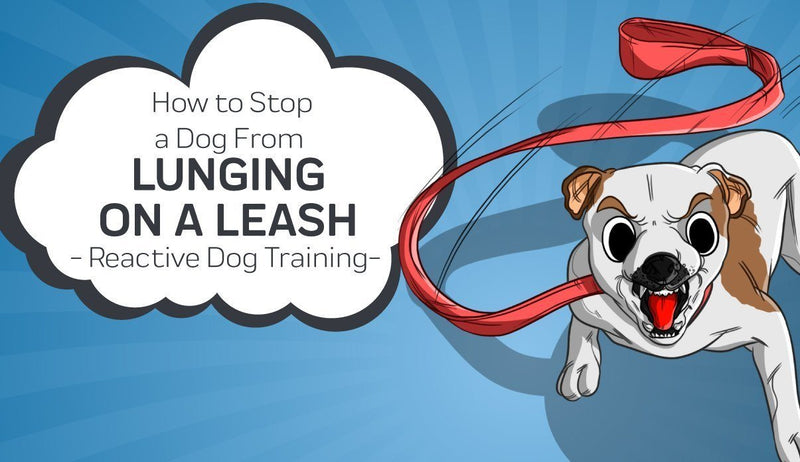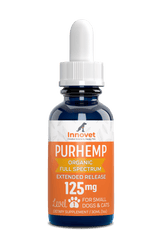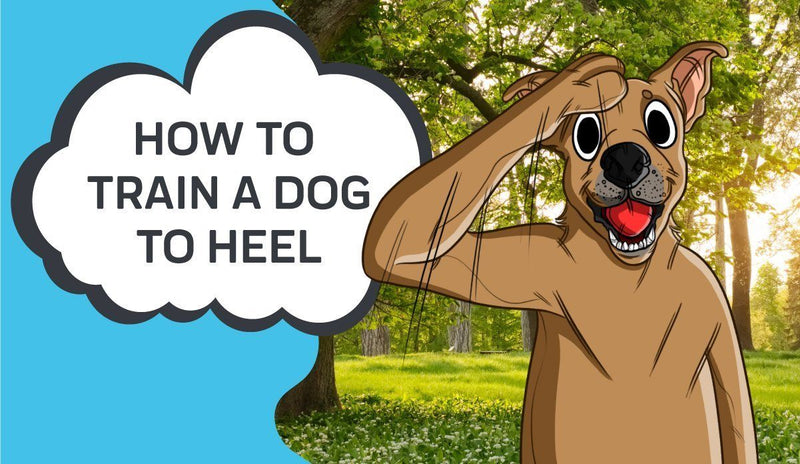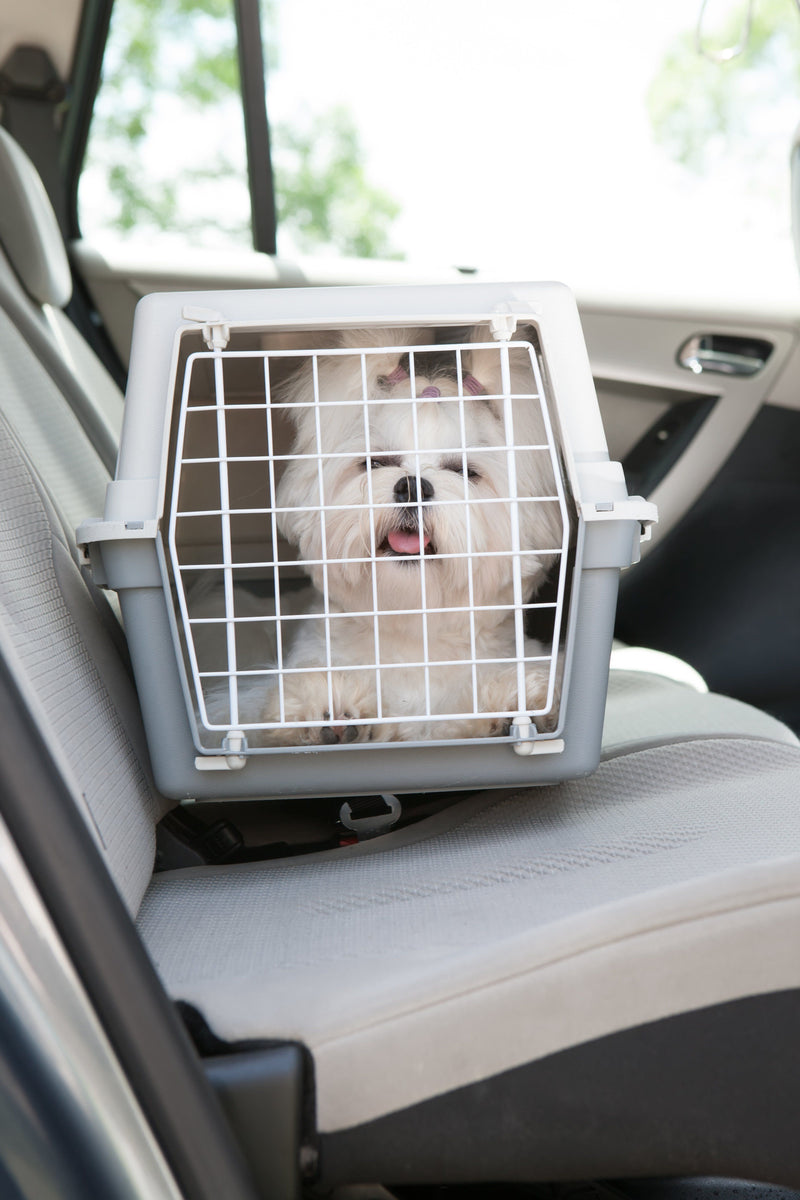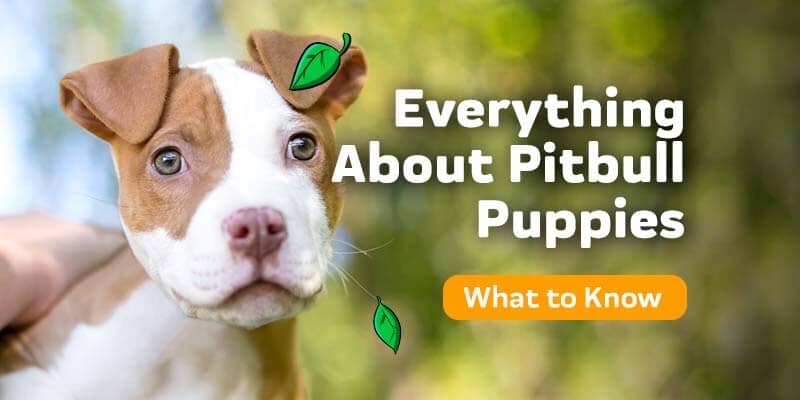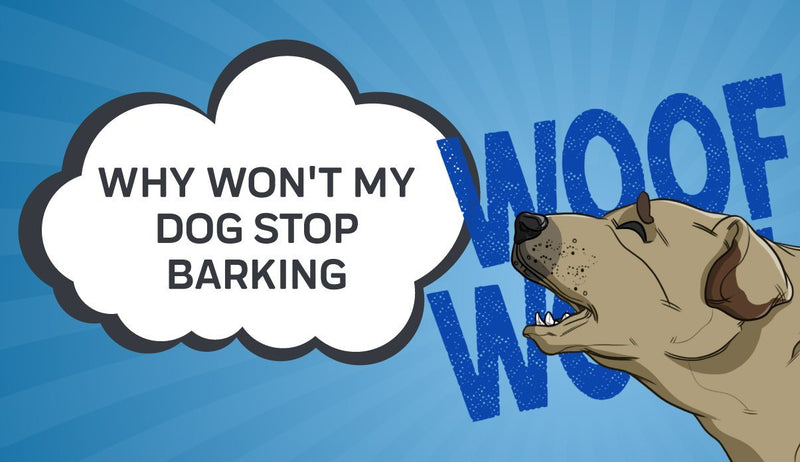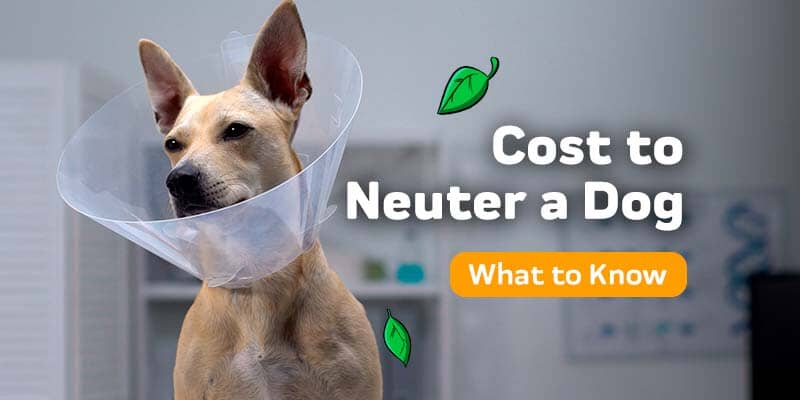More than 200 people every month search for "how to stop a dog from lunging on a leash," meaning there are a lot of dogs who seem aggressive and hard to manage, potentially even dangerous when all they really need is reactive dog training.
What is a reactive dog?

A reactive dog has an exaggerated response to stimuli such as seeing other dogs, other animals, and people, and hearing triggering noises. Taking an offensive posture around dogs and humans is the most common form of reactivity in dogs.
It also occurs most often when the dog is on the leash, but dogs can also be reactive in the car or at home.
Reactivity in dogs makes walks, car rides, or daily living a stressful event, and it can lead to dangerous situations for others and your dog. Without reactive dog training, your dog may be considered a threat and/or you may have to surrender them.
The stages of reactivity in dogs
Reactivity will begin with signs of anxiety, such as unusual barking, panting, whining, hyper excitability, and hyper vigilance in the presence of dogs, humans, and other animals.
Eventually they will begin making offensive postures like snarling, worsened barking, and lunging.
Left unaddressed or improperly addressed(as in you made the dog more anxious), the dog can become violent. It will then become unsafe to take them for walks, have them in the car, etc.
Why are dogs reactive? What are they thinking?
Reactive dogs are insecure and taking aggressive measures to alleviate their anxiety. That is why you have to be mindful of the dog's mental state to effectively manage reactivity. You can't control or scold them out of it. They have a feeling and will act. This feeling actually wires their brain in a certain way that they can't help. Thankfully, you can rewrite this with the right training, specific reactive dog training.
Reactive Dog Training Tips
Why Reactive Dog Training?
The dog is insecure and acting on that insecurity. Watching them lunge when on the leash with you is alarming and your natural instincts may be to pull at their leash or yell. Your fear just makes the dog more afraid, and scolding them, pulling on the leash, and other similar actions cause negative associations with walks and socialization. These negative associations will actually make the dog more reactive. Now they just have more to be upset about.
To address reactivity, you have to take control, remain calm, and use methods that will lessen the dog's anxiety.
Timeframe for reactive dog training
There isn't a quick fix for reactive dogs. It is a deep-seated problem, built up over a long time or caused by chemicals in the brain.
You can help your reactive dog. Just don't get discouraged or blame them when you don't get quick results and do be prepared to carry out the training for a length of time.
Some dogs may be "cured" of reactivity in a matter of days while others may take weeks or months. You will have to maintain your cool attitude and training methods even after they begin to act normally to ensure they stay calm, and if they suffer a severe mental strain, reactivity might come back. You will then have to train them again.
Steps of reactive dog training
Dog blinders - too easy?
The easiest tactic is to slap dog blinders on your dog. If they can't see the trigger, how can they can get upset by it? Well, blinders only cover part of the dog's vision, so the dog is still capable of seeing other dogs and people, just not as often. And having their vision obscured can make the dog more anxious. We don't like being blind, even if it is just part of our vision. It can make dogs anxious too. Imagine feeling that someone is threatening you and not being able to see what's happening.
There is a remote possibility that a dog may actually respond well to dog blinders, the fear of not being able to see being less than the fear of what they're seeing. You could try blinders if you wish, but don't neglect the rest of their training and don't be surprised if it doesn't work.
Choose the right collar or harness
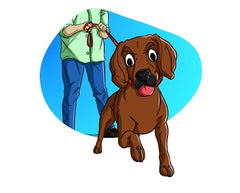
Don't use retractable leashes or pull harnesses because they encourage dogs to pull on the leash, which is way too close to lunging. It also creates pressure on the body that doesn't feel good and can cause negative associations. Make walks less stressful for the dog and for you with the right collar or harness. Find one that gives you greater control with encouraging lunging like a head halter or no-pull harness. This way, you can stop the dog should things get really ugly.
Also don't choose choke chains or prong leashes. Pain and discomfort increase anxiety and negative associations and will make dog reactivity worse.
Limit exposure
Begin the training by limiting their exposure to triggers so it only happens at times when you can intervene and help them respond differently. When they are in the home or yard, cover the windows, glass doors, and openings in the fence so they don't see people or dogs when you are not present and ready to intervene.
Walk the dog in areas with fewer dogs and people, or none, if that is possible.
Improve leash training
While walking the dog in a less triggering environment, improve their leash training. Teach them or strengthen their awareness of making eye contact with you, the sit and down commands, and walking on the leash without pulling. Use online or DVD videos as guides or contact a local trainer for help.
This training will help you keep control over the situation and therefore create a more secure walking experience for the dog. You won't get so upset when they react, and you can direct their attention from the trigger.
Reintroduce

Notice how close your dog has to get to the trigger before becoming upset. Bring them where they are just outside this limit, they can see the trigger, but it is far enough away that they do not get upset. Then practice the training exercises with them. Every time they see a trigger and don't get upset, give them a treat or praise them. This rewires their brain to think of something positive in association with the trigger. When they are well trained on the leash, take them back to places where they will interact with dogs and humans.
It won't take long for them to start expecting the treat or praise when they see the trigger. This will make them look to you each time. Reward them when they turn to you instead of getting upset. Do this until it becomes a consistent pattern.
Bring the dog a little closer to a trigger. If they aren't upset, try the training steps and reward them when they look at you instead of reacting to the trigger.
When they can routinely be this close to a trigger without reacting, move them closer and repeat the steps again. You will want to do this as many times as it takes to get the dog to where they can engage in as many normal behaviors as possible without reacting.
Don't push the dog too hard or it may make you both have to backtrack. Remember, the goal is to make them feel secure.
Some dogs may always have to have some limits put on their behavior. Meaning, they can't socialize in all environments. If you try for more than several months and your dog still reacts at close proximity to other dogs and humans, you may have to always keep them from having to get that close. Just be thankful for what progress you did make.
Reactivity and Depression in Dogs
Depression and reactivity often go together. A depressed dog is more likely to be a reactive dog because reactivity is an emotional issue, stemming from insecurity.
To properly manage reactivity in dogs, you may have to treat anxiety and depression as well. The best training can't override a mental illness. That'd be like trying to train depression out of a human.
If reactive dog training doesn't fix the problem, or you already see evidence that your dog may be depressed or anxious, you should mix depression treatments into your strategy.
Lifestyle changes to improve depression should be tried, things like ensuring they get plenty of exercise as well as socialization that they are comfortable with. Spend quality time with them and as much of it as you can.
You might also need to try medication for reactive dogs. What do they give reactive dogs? Antidepressants.
How CBD Oil Might Help with Reactive Dog Training
CBD oil helps dogs with depression and anxiety. When giving them a treat, you might give them a CBD oil treat to both reward them and give them a dose of CBD oil at the same time. Just be sure not to exceed their daily dose requirements.
It would probably be more helpful to routinely give them CBD oil treats or a tincture twice a day to help keep their general anxiety and depression level down, like a medicine.
Using CBD Oil
You have several options for using CBD oil to help manage anxiety and depression:
- oil tinctures
- extract concentrates
- capsules
- treats
Extract concentrates are concentrated cannabidiol(the main ingredient in CBD oil). It comes in a tube that dispenses the cannabidiol in beads that you can measure to find any dose you need. It can be given by mouth or in food. There is only one ingredient in extract concentrates, and it is the most cost-effective form of CBD oil. The downside is that it has no flavoring, so if the dog doesn't like the distinctive hemp taste, you'll have to mask it in a stronger tasting food or beverage.
Capsules are convenient, taste-free ways to give dogs CBD oil in the same dose each time.
Oil tinctures combine cannabidiol with a carrier oil and usually a flavoring to provide the flexibility to vary doses in an enjoyable form. It comes in a dropper or sprayer so you can measure by drops and sprays and apply the tincture directly to their mouth or in their food.
Treats are the most fun option. They are treats after all. Like capsules, you don't have dose flexibility.
Dosing CBD Oil
Treats and capsules come in specific doses and will tell you on the package how many to give your small, medium, or large dog.
Puppies, senior dogs, unusually small or unusually large, or very sick dogs will need different dosing.
When you want to vary doses at different times of the day or to find a unique dose for your dog, extract concentrates and oil tinctures provide the control you need. You might also enjoy having one container of a CBD oil concentrate or tincture so you can vary the dose for all the pets in your home, if needed.
Start with the lowest possible dose for your dog's size and tweak the dose as needed to provide relief. It is safer and less stressful to work up.
Risks Associated with CBD Oil
CBD oil is pretty safe, that's why it's growing so much in popularity. But that doesn't mean there aren't some things you should know to keep your dog 100% safe.
Cannabidiol is pretty much considered side effect free. Most dogs will not have side effects. It is possible for them to develop a loss of appetite, diarrhea, or sedation, particularly if they are taking a large amount.
CBD oil alters how the liver absorbs medications, so any medication handled by the liver will need to be dosed differently when your dog is taking CBD oil. Studies also show mixed results regarding whether CBD oil has a positive or negative (like alcohol or acetaminophen in humans) effect on the liver, so if you have reason to be particularly concerned about liver issues you could discuss risks versus benefits with your vet.
CBD oil products have not been approved by the FDA yet because they haven't been studied long enough. One CBD oil drug for epilepsy has been approved, prioritized because the need to get this gentle anti-seizure medicine was so great. Until CBD oil in general has been FDA approved, it is still considered largely experimental, so results are not guaranteed. It is a natural substance that shows great promise at addressing many hard-to-treat ailments, but we're all still learning about it.
If your vet is not supportive of the use of CBD oil, that doesn't mean everyone in your area will feel the same. The number of vets jumping on the CBD oil train grows continually, so call around or consider a holistic vet who approves CBD.
Purchasing CBD Oil
Educate yourself before buying any CBD oil product to make the best choice for your dog.
CBD isolate or Full-spectrum CBD
CBD isolate contains only cannabidiol where full-spectrum CBD oil contains cannabidiol, other cannabinoids besides THC, terpenes, and nutrients that come from the hemp plant. Most people prefer full-spectrum because the retained components create an entourage effect that heightens the effectiveness of cannabidiol, but there are others who find that CBD isolate actually works best for them. Try one and if it doesn't work for your dog, try the other.
Third-party testing
Only buy your dog CBD oil that has been third-party tested. You will know this because the manufacturer displays the results on the website. Make sure you also read the results. This will protect you from giving your dog CBD oil that contains less cannabidiol than promised or no cannabidiol at all. Here is an example: our test results from each batch of PurCBD+ 125mg.
Origin
The CBD oil manufacturer should also tell you where they acquired their hemp. They may grow the hemp and extract the cannabidiol themselves or they may buy the hemp or cannabidiol from someone else. Either way, you should be told where the hemp came from to ensure it was grown under safe agricultural regulations.
Extraction
You should also look for mention of the extraction method on the manufacturer's website. The CO2 method is the safest and purest option, so choose it.
Ingredients
Fewer ingredients indicates that the company avoided putting unnecessary or unsafe things in their product. It also helps you research what is in it so you can guarantee that it is safe and non-allergenic to your pet.
Extract concentrates should only have one ingredient, tinctures a small number consisting of the carrier oil and flavorings, capsules require more ingredients to turn cannabidiol into a pill form, and treats will have a good amount of ingredients to make it a crunchy or soft form and have a great taste. Even with capsules and treats, you should be able to prove the safety of all of the ingredients and the number of ingredients should be the lowest possible amount.
Innovations from Innovet
If your dog isn't helped by any traditional or natural methods, contact us to see if we can find a new solution for them. Innovating for pets is our thing. We love finding creative, eco-friendly solutions for pet ownership challenges and hard-to-treat pet ailments. Reactive dog training is one such trial that we help address with CBD oil tinctures, capsules, as well as crunchy treats and soft treats for anxiety and depression. While in our store, you might also want to check out our anti-pest, dental, and ear cleaning products to make pet care and outdoor time easier.
Sources:
How Do I Stop My Dog From Lunging at Other Dogs on Walks?Managing a leash-reactive dog
Therapeutic Potential of Cannabidiol
Cannabidiol as a Potential Treatment for Anxiety Disorders
Approved by:
Dr. Sara Ochoa
Doctor of Veterinary Medicine, St. Georges University

Thanks for stopping by!
P.S. We Love You!
Sincerely,
The Innovet Team
Please do not ask for emergency or specific medical questions about your pets in the comments. Innovet Pet Products is unable to provide you with specific medical advice or counseling. A detailed physical exam, patient history, and an established veterinarian are required to provide specific medical advice. If you are worried that your pet requires emergency attention or if you have specific medical questions related to your pet’s current or chronic health conditions, please contact or visit your local/preferred veterinarian, an animal-specific poison control hotline, or your local emergency veterinary care center.
Please share your experiences and stories, your opinions and feedback about this blog, or what you've learned that you'd like to share with others.










